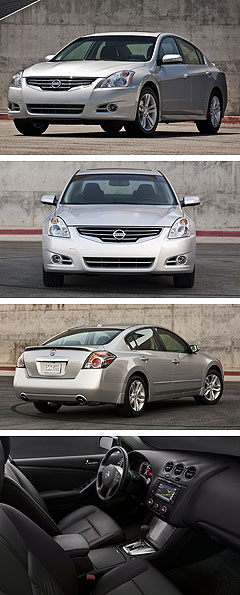First drive: Nissan Altima to usher in new CVT
BY BYRON MATHIOUDAKIS | 6th Dec 2011

Designed for a wide range of front-wheel-drive vehicles with four-cylinder and V6 engines ranging from 2.0 to 3.5-litres, it will debut in the United States-built L33 Altima, beginning next year.
This model is set to replace the current lower-end V6-only J32 Maxima range (250 ST-L) in Australia sometime in 2013 but at a much keener price than today’s $33,990 opener, giving Nissan its first true medium-sized four-cylinder sedan opponent against the Camry since the demise of the U13 Bluebird – ironically a direct ancestor of Altima – 15 years ago.
It is believed that a larger, next-generation, American-made Maxima may slot in for higher-end J32s sometime around 2014, as GoAuto has learned that Nissan is not keen to kill off the 20-year-old nameplate in Australia just yet.
More L33 Altima details will emerge ahead of its global debut – probably at the Chicago motor show – in February.
In the meantime, Nissan fitted the upcoming CVT hardware to an existing (L32) Altima for the world’s press to sample last week.

As applied to the 2.5-litre four-cylinder petrol engine that will form the mainstay of Altima’s global medium segment assault (though the US-market V6 petrol-equipped models may also make it to Australia), the gearbox itself brings up to 10 per cent improvement in fuel economy compared to previous comparable vehicles equipped with CVT, the firm promises.
Driven briefly around a test track at Nissan’s GranDrive facility in Oppama, near Tokyo, the outgoing Altima prototype could not prove that figure. The exercise involved hard acceleration, various cruising stretches at 80km/h and 120km/h, and some simulated passing manoeuvres. Not exactly a detailed examination, then.
However, as far as Nissan’s other claim – that the new X-tronic provides a true linear driving feel with friction reduced by up to 40 per cent – was concerned, the evidence seemed compelling.
Basically, the next CVT features an expanded ratio coverage of 7.0, with only minimally increased axial distance, by combining smaller shaft-diameter pulleys with a new and differently shaped belt, Nissan says. This is a production world-first for an engine more than two-litres.
Friction is cut through the adoption of a smaller oil pump (which reduces oil leak and excess oil pressure properties), lower-viscosity oil and modified internal parts designed to operate more smoothly.
Nissan has also incorporated new software dubbed adaptive shift control (ASC) that ‘intelligently’ selects the optimal gear ratio according to how the driver accelerates, brakes, and corners. Among other things, it co-ordinates engine speed with vehicle speed for a heightened sense of acceleration.
Existing CVTs in larger Nissans – think today’s Dualis, X-Trail and Maxima – are fine when tootling about quietly, but suffer from a number of undesirable traits if you up the ante a little. Think laggy acceleration and slipping-clutch ‘flaring’ sensations as the pedal pressure applied is not proportionate to how fast you are travelling, accompanied by a droney constant revving noise that isn’t at all appealing. None of these applied to the Altima with future X-tronic.
Easily the best CVT we have ever experienced, the gap between it and a modern six-speed conventional torque-converter automatic was virtually impossible to differentiate.
The transmission has no hesitation at start-up, and delivers stronger and more responsive acceleration than anticipated, with a slick, almost dual-clutch smoothness on ratio changes.
In one fell swoop Nissan seems to have eliminated all current CVT issues. From 2013 X-tronic might even become a byword for fast, responsive, lag-free, drone-free and enjoyable to drive.
Only the existing Altima’s dead steering ruined the feeling.
The company is committed to the CVT because it feels this route is the best way to lower fuel consumption and, consequently, emissions in affordable family cars.
Nissan’s upcoming 2.5-litre supercharged four-cylinder petrol/electric hybrid drivetrain – also to debut in the next Altima and almost a certainty for Australia from 2014 – will further evolve the CVT, incorporating one electric motor and two clutches into the new X-tronic gear, along with a lithium-ion battery.
Insiders claim the 2013 Altima will be one of the most daring Nissan sedans in decades, as well as one of the best to drive.
After our all-too-brief stint behind the gear lever of the next-generation X-tronic prototype, we can at least vouch for part of that statement.
The car born to conquer Camry globally just got a whole lot more interesting.